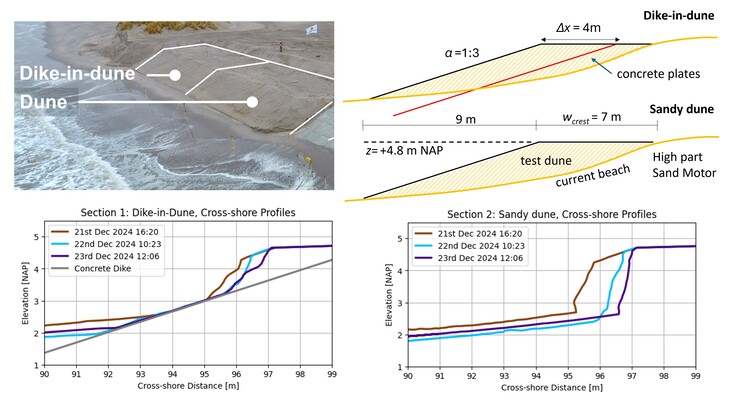R.G.C. Rosman¹,², D.W. Poppema¹, S. De Vries¹, M.D. Klein², M.F.S. Tissier¹, A. Antonini¹
¹ Delft University of Technology, Netherlands – ² Royal Boskalis Westminster N.V., Netherlands
* r.g.c.rosman@student.tudelft.nl
Introduction
Rising sea levels and intensifying storm events are increasing the risks of coastal erosion and flooding. This underscores the need for innovative and sustainable coastal defense strategies, such as hybrid dunes (“dike-in-dune”), in addition to traditional sandy dunes (Almarshed et al., 2019). Hybrid dune structures combine the natural buffering capacity of sandy dunes with the structural stability of a dike, potentially offering a more resilient approach to coastal protection. This study compares the erosion response of hybrid and sandy dune systems during a high-energy storm surge in a field experiment on the Sand Engine near The Hague, Netherlands.
Objective and Methods
As part of the Hybrid Dune project, four different dike/dune sections were constructed at an erosive location to assess their erodibility. This study focuses on Section 1 (Hybrid Dune) and Section 2 (Sandy Dune) during the period of December 21–23, 2024, when the dunes were exposed to multiple high-water events with two largest peak levels of 2.1 and 1.7 m NAP.
To measure morphological changes, high-frequency 3D laser scanners were installed in front of the dune sections. These scanners recorded cross-shore profiles, enabling high-resolution detection of erosion and sediment redistribution patterns. While LiDAR technology has been rarely applied in coastal studies to capture fine-scale morphological changes, it has been successfully demonstrated in previous work (Van Wiechen et al., 2024)
Results
The bottom-left panel of the figure presents the cross-shore profiles of Section 1 (Hybrid Dune), showing a 30–50 cm retreat of the dune face following high water on December 22. During the subsequent high-water event (1.8 m NAP), the dune crest retreated an additional 30 cm, while the beach profile increased by 2–8 cm, indicating sediment accumulation.
The bottom-right panel illustrates Section 2 (Sandy Dune), where the dune face retreated by 1.0 m after the first high-water event. The second high tide caused a further 30 cm retreat, with sediment transported offshore. However, the beach profile increased by 10 cm, suggesting sediment redistribution and partial recovery.
Despite differences in structure, both dune sections exhibited a similar pattern of initial dune face erosion followed by beach elevation, indicating comparable sediment redistribution. While the hybrid dune reduced landward erosion, sediment dynamics in front of the dune remained similar to those in a fully sandy system. This suggests that hybrid dunes can enhance coastal safety by providing structural protection while still facilitating natural sediment transport, supporting long-term resilience to storm-induced erosion.

Overview of the Hybrid-Dune project, focusing on Sections 1 and 2. The bottom-left panel illustrates the cross-shore profile of Section 1 (Hybrid Dune), while the bottom-right panel presents the cross-shore profile of Section 2 (Sandy Dune), both recorded between December 21–23, 2024.
References
-
- Almarshed, B., Figlus, J., Miller, J., & Verhagen, H. J. (2019). Innovative coastal risk reduction through hybrid design: Combining sand cover and structural defenses. Journal of Coastal Research, 36(1), 174–188. https://doi.org/10.2112/JCOASTRES-D-18-00062.1
- van Wiechen, P. P. J., Mieras, R., Tissier, M. F. S., & de Vries, S. (2024). Coastal dune erosion and slumping processes in the swash-dune collision regime based on field measurements. Journal of Geophysical Research: Earth Surface, 129(10), e2024JF007711. https://doi.org/10.1029/2024JF007711










